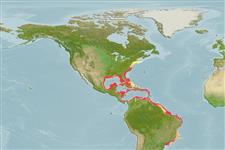>
Eupercaria/misc (Various families in series Eupercaria) >
Lutjanidae (Snappers) > Lutjaninae
Etymology: Ocyurus: Greek, okys = quick + Greek, oura = tail.
More on author: Bloch.
Environment: milieu / climate zone / depth range / distribution range
экология
морской ассоциированный с рифами; пределы глубины 0 - 180 m (Ref. 10795), usually 10 - 70 m (Ref. 55229). Subtropical; 42°N - 26°S, 98°W - 31°W (Ref. 55229)
Western Atlantic: extending northward to Massachusetts, USA and Bermuda and southward to southeastern Brazil, in Gulf of Mexico and Antilles (Anderson, pers. comm.). Most common in the Bahamas, off south Florida and throughout the Caribbean. Lutjanus ambiguus (Poey, 1860), an intergeneric hybrid with Lutjanus synagris (Linnaeus) as demonstrated by Loftus (1992: Ref. 33006), followed by McEachran &. Fechhelm (2005: Ref. 78464).
Length at first maturity / Size / Вес / Возраст
Maturity: Lm 23.8, range 14 - 31 cm
Max length : 86.3 cm TL самец/пол неопределен; (Ref. 9626); common length : 40.0 cm TL самец/пол неопределен; (Ref. 55); наибольший вес (опубликованные данные): 4.1 kg (Ref. 40637); наибольший возраст (опубликованны данные): 14 годы (Ref. 3090)
колючие лучи спинного плавника (общее число) : 10; членистые (мягкие) лучи спинного плавника (общее число) : 12 - 14; колючие лучи анального плавника: 3; членистые (мягкие) лучи анального плавника: 8 - 9. Head relatively small, lower jaw projecting slightly beyond the upper. Scale rows on back rising obliquely above lateral line. Back and upper sides blue to violet with scattered yellow spots. A prominent mid-lateral yellow band running from the snout to the caudal fin base. The lower sides and belly whitish with narrow reddish and yellow stripes; the dorsal and caudal fins yellow; the anal and pelvic fins whitish.
Adults inhabit coastal waters, mostly around coral reefs. Usually seen well above the bottom, frequently in aggregations. They feed on a combination of plankton and benthic animals including fishes, crustaceans, worms, gastropods and cephalopods, mainly at night (Ref. 9987). Young individuals are usually found over weed beds. They feed primarily on plankton (Ref. 9710). Spawning occurs throughout the year, with peaks at different times in different areas (Ref. 26938). Marketed fresh and frozen (Ref. 9987). Has been reared in captivity (Ref. 35420).
Allen, G.R., 1985. FAO Species Catalogue. Vol. 6. Snappers of the world. An annotated and illustrated catalogue of lutjanid species known to date. FAO Fish. Synop. 125(6):208 p. Rome: FAO. (Ref. 55)
Статус Красного Списка МСОП (Ref. 130435: Version 2024-2)
Угроза для людей
Reports of ciguatera poisoning (Ref. 30911)
Использование человеком
рыболовство: коммерческий; аквакультура (рыбоводство): коммерческий; объект спортивного рыболовства: да; аквариум: общественные аквариумы
дополнительная информация
инструменты
Специальные отчеты
Скачать в формате XML
ресурсы в Интернет
Estimates based on models
Preferred temperature (Ref.
123201): 21.7 - 27.9, mean 25.9 °C (based on 650 cells).
Phylogenetic diversity index (Ref.
82804): PD
50 = 1.0000 [Uniqueness, from 0.5 = low to 2.0 = high].
Bayesian length-weight: a=0.01514 (0.01348 - 0.01700), b=2.95 (2.92 - 2.98), in cm total length, based on LWR estimates for this species (Ref.
93245).
Trophic level (Ref.
69278): 4.0 ±0.3 se; based on diet studies.
Generation time: 6.9 (3.9 - 8.5) years. Estimated as median ln(3)/K based on 16
growth studies.
устойчивость к внешним воздействиям (Ref.
120179): средний (среднего размера), минимальное время удвоения популяции 1.4-4.4 года (K=0.10-0.16; tm=2; tmax=14).
Prior r = 0.63, 95% CL = 0.42 - 0.95, Based on 8 data-limited stock assessments.
Fishing Vulnerability (Ref.
59153): Moderate vulnerability (38 of 100).
Climate Vulnerability (Ref.
125649): Very high vulnerability (88 of 100).
Nutrients (Ref.
124155): Calcium = 13.5 [7.7, 25.9] mg/100g; Iron = 0.473 [0.242, 0.840] mg/100g; Protein = 19.5 [17.6, 21.1] %; Omega3 = 0.207 [0.117, 0.352] g/100g; Selenium = 22.4 [11.0, 44.1] μg/100g; VitaminA = 69.2 [21.7, 245.3] μg/100g; Zinc = 0.572 [0.377, 0.858] mg/100g (wet weight); based on
nutrient studies.
